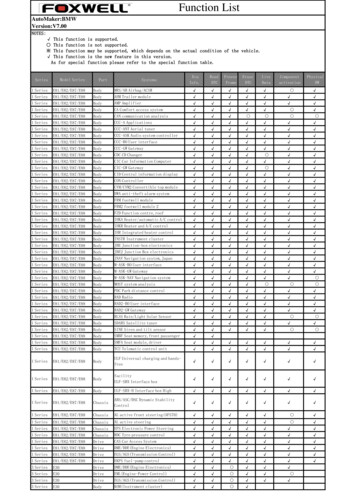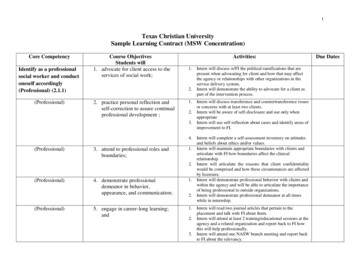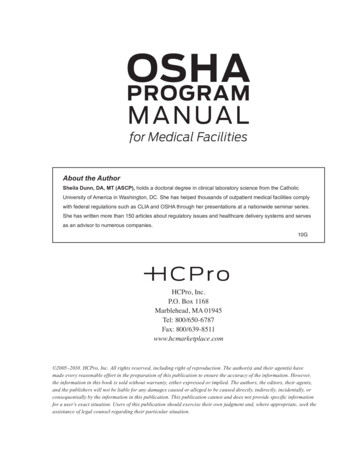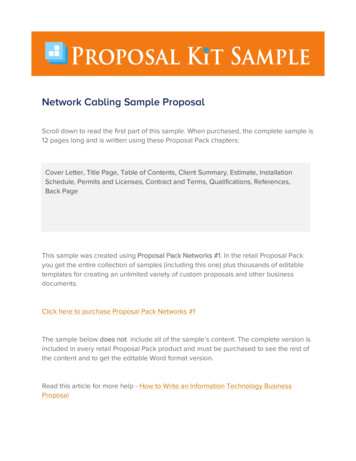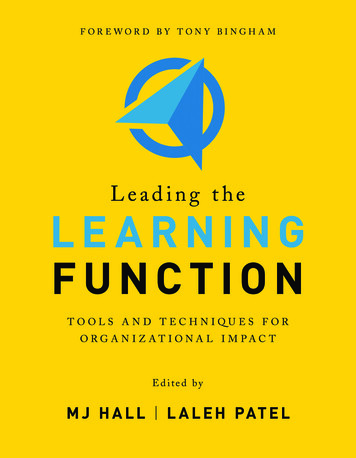
Transcription
More Praise for Leading the Learning Function“This is a wonderful guide to the elements that make a great culture of learning. Born from a true collaboration amonglearning leaders—at organizations like Accenture, American Airlines, Deloitte, Grainger, IBM, and UPS to name afew—Leading the Learning Function shares important new perspectives and effective strategies.”—Britt Andreatta, PhD, CEO, Britt Andreatta Training Solutions“The ATD Forum has done a masterful job compiling best practices, innovative tools and techniques, and strategic processesfrom over 40 senior practitioner members. If you are looking for how-to examples to enhance performance and elevate thevalue and impact of your learning function, look no further than this must-have resource for all learning leaders!”—Rita Bailey, Owner, Up To Something“The future of work may be uncertain, but one thing is for sure—there will always be a need for continual upskillingof the workforce and talent leaders who can achieve it with a sound strategy and tried and tested tools and techniques.This book showcases innovations for today and provides fuel for tomorrow.”—Elaine Biech, Author, The New Business of Consulting and ATD’s Foundations of Talent Development“Leading the Learning Function is full of real-life examples that demonstrate how to turn leadership theory into practice.You’ll find tips, tools, and techniques that will help you excel at any level of leadership. Read this book and be a betterlearning leader!”—Ken Blanchard, Co-Author, The New One Minute Manager and Leading at a Higher Level“This extensive, but practical, collection of processes, practices, stories, tools, and techniques from successfulpractitioners in a variety of industries provides the fundamentals for enabling all learning leaders to build organizationalcapability that produces impactful results. Leading the Learning Function is the new go-to source for all talent professionals.”—Marshall Goldsmith, New York Times #1 Bestselling Author, Triggers, Mojo, and What Got You Here Won’t Get You There“Compulsory reading for any future-focused leader wanting to put talent development at the heart of their organization’ssuccess. Leading the Learning Function draws into one volume the distilled wisdom of seasoned learning leaders who prove thatintentional learning transforms organizations.”—Jonathan Halls, Author, Confessions of a Corporate Trainer“This book is a smorgasbord of learning and development ideas, content, and inspiration that will provide anyone leadingthe L&D function with targeted, focused, and actionable information to take their organization to the next level and beyond.”—Karl M. Kapp, EdD, Professor of Instructional Design and Technology, Bloomsburg University“Experience is the best teacher as long as we learn from it. And that’s what the contributors to this book have done.Kudos to MJ Hall and Laleh Patel for bringing together a phenomenal group of on-the-ground experts who share theirstrategies, techniques, dashboards, examples, best practices, and lessons learned. It’s a treasure trove of essentials forthe 21st-century talent developer who needs relevant, experience-based, and practical information to help guide themthrough the challenges of preparing today’s workforce. If you want to thrive in the future, prepare in the present byputting Leading the Learning Function to use in your organization.”— Jim Kouzes, Co-Author, The Leadership Challenge, and Executive Fellow, Center for Innovation and Entrepreneurship,Leavey School of Business, Santa Clara University“Leading the Learning Function offers insights into the key leverage points for impact, innovation, and engagement. It isoverflowing with creative ideas and best practices from leading talent development practitioner experts who are servingon the front lines.”—Manuel London, PhD, Dean, College of Business, State University of New York at Stony Brook
“Leading the Learning Function is a must-read for anyone who needs practical, step-by-step guidance for identifying,acquiring, and growing talent in any organization. Loaded with time-tested models, results-enabling questions, andeasy-to-implement best practices refined from the experiences of 31 expert TD professionals, this book provides timelessresources every leader needs to maximize human potential with guided confidence and expertise. If you’re seeking a roadmap for achieving real, measurable, and scalable impact, this is it!”—Sardek P. Love, CEO, Sardek Love International“Learning can be natural, yet leading learning requires strategy, agility, readiness, divergence, collaboration, andleadership. Leading the Learning Function provides the tools and strategies essential for strategically driving learning in ourevolving organizations.”—Elliott Masie, Chair, The Learning CONSORTIUM @ The MASIE Center“In Leading the Learning Function, you’ll get a unique look into the challenges that experienced learning leaders face as youread their reflections, practical experience, and advice. Additionally, the editors infuse a layer of value-adding insights tohelp you see the larger story unfolding in talent development: organizations are transforming, and learning is the dynamicthat makes this transformation possible. These are creative times for the learning and development field, and the lessonsin this book will catalyze you and your team!”—Pat McLagan, Author, Unstoppable You“I found Leading the Learning Function to be highly pragmatic in its approach and thorough in its review of the latestthinking in learning. I especially liked how it pivoted on creating programs directed at performance outcomes through apowerful combination of the use of strategy, methodology, and technology.”—Bob Mosher, CEO and Chief Learning Evangelist, Apply Synergies: THE 5 Moments of Need Company“How do leaders add value? The Center for Leadership Studies, through the eyes of Situational Leadership , says:Leaders accelerate the development of those around them. Hall and Patel deserve thanks for their tireless efforts inputting together a comprehensive reference that will undoubtedly help the leaders of learning functions around the worldachieve this objective!”—Sam Shriver, EdD, Executive Vice President, The Center for Leadership Studies“Congratulations to the more than 50 practitioners from across a variety of industries for this huge contribution tothe learning profession. Leading the Learning Function is full of practical tips, examples, and tools, written in a style thatencourages readers to experiment and take action. It is a must have handbook for all talent professionals!”—Brenda Sugrue, Global Chief Learning Officer, EY“Leading the Learning Function is one of a kind: real learning leaders sharing their experiences and lessons learned. This isnot an academic or formulaic checklist of to-dos, but rather an unplugged collection of tips and resources for you to useto excel at all phases of leadership—planning, strategy, execution, and measuring impact.”—Megan Torrance, CEO, TorranceLearning“What impresses me most about Leading the Learning Function is how it combines theory with practical application. As leaders,we’ve all read about what should work in L&D; it’s refreshing to read instead about what does work. This book taps into theexpertise of industry leaders, packages that expertise into effective strategies and, most importantly, explores the why behindapplying those strategies to your business. I’d recommend it for any leader in the rapidly changing world of L&D.”—Andy Trainor, Vice President, Learning, Walmart U.S.
ContentsForward by Tony Bingham.vIntroduction. ixSection 1: Setting Direction. 1Chapter 1: Synching Up for Synergyby Lisa Gary. 3Chapter 2: A Proactive Approach to Strategic Learning Alignmentby Sandi Maxey. 15Chapter 3: Strategy Revealed: A Personal Experience Journeyby Teri Lowe. 27Chapter 4: So, You Want to Be Strategic?by John Kelly. 41Section 2: Managing Processes and Projects. 53Chapter 5: Organizational Needs: Determining Gaps and Aligning Solutionsby Chris Garton and MJ Hall. 55Chapter 6: Heeding the Callby Jerry Kaminski With MJ Hall. 71Chapter 7: Leveraging Neuroscience in Learning Designby Leanne Drennan, Casey Garhart, and Joan McKernan. 85Chapter 8: Iteration, Not Perfectionby Suzanne Frawley. 95Chapter 9: The 70-20-10 Framework: Options for Impactby Alan Abbott and Rachel Hutchinson. 109Section 3: Leading and Developing People. 121Chapter 10: Identifying and Onboarding the Best Talentby Sarah Siegel and Elizabeth Huttner-Loan. 123Chapter 11: Enabling Continuous Learning: Tools and Approaches to Make It Happenby Laura Solomon and Caroline Fernandes. 135Chapter 12: Develop Your Team to Develop Their Teamby Alissa Weiher With MJ Hall. 155Section 4: Making an Impact. 165Chapter 13: Metrics Matterby Rachel Hutchinson.167Chapter 14: A Dashboard Journeyby Ron Dickson. 181Chapter 15: Impact: Making It Happenby Graham Johnston. 197
Section 5: Stakeholder Collaboration. 207Chapter 16: Go Slow To Go Fastby Marie Wehrung. 209Chapter 17: The Impact of Coalitionsby Bryan McElroy, Rachel Hutchinson, Emily Isensee, and David McGrath With MJ Hall. 227Chapter 18: Structure and Governanceby Kozetta Chapman and Graham Johnston With MJ Hall. 241Section 6: Enabling Learning Using Technology. 253Chapter 19: Is Tech the Answer?by Jerry Kaminski. 255Chapter 20: Taking the Fear Out of the Technology Jungleby Terry Copley. 267Chapter 21: The Role of L&D in the Digital Ageby Brandon Carson. 279Section 7: Innovation. 289Chapter 22: Business Impact Through Learning Research and Innovationby Dana Alan Koch, Michelle M. Webb, and Tanya Gilson. 291Chapter 23: Innovation in Learningby Graham Johnston. 311Chapter 24: Changing Times: Innovate for Impactby Ann Quadagno and Catherine Rickelman. 319Section 8: Leader Behavior and Practices. 339Chapter 25: Leadership: Enabling Others to Move the Needleby MJ Hall. 341Chapter 26: Getting Better at Getting Better: Tools and Techniquesby MJ Hall. 355Acknowledgments. 369Appendix 1: Suggestions for Professional Organizations. 373Appendix 2: Technology Platforms and Systems. 375Appendix 3: More Tools and Techniques for Enhancing Personal Leadership Capability. 377References. 381About the Authors. 389About the Editors. 401Index. 403iv Contents
ForewordTony Bingham“Learning is a force multiplier,” write MJ Hall and Laleh Patel in the introduction to Leading the LearningFunction: Tools and Techniques for Organizational Impact. It’s a compelling statement because it evokes the powerof what learning can accomplish. When harnessed, focused, and intentional, learning has the power toshift behaviors, beliefs, outcomes, systems, and societies. We were already in an era of unprecedentedchange before the coronavirus pandemic spread across the globe. In early 2020 we were seeing significantshifts in business, in science, in creativity, in technology, and in jobs. The global shutdown that resultedfrom the pandemic redefined almost every facet of society and it is apparent that we stand at the edge ofwhat could be called the Era of Mass Disruption. The work of professionals who are committed to thedevelopment of knowledge, skill, and capability in the global workforce is absolutely critical today.Likewise, the role of leaders and the development of leadership capability is paramount if we areto truly realize the potential of what talent development efforts can accomplish in organizations aroundthe world. Learning as a strategic function requires talent professionals to lead. Real leadership is aboutgrowing future leaders while casting a vision for what is possible and how to achieve it.Learning empowers. Developing talent empowers. Leadership empowers.In 1991 when the ASTD Benchmarking Forum was created, the idea was simple: Provide a privateconsortium in which learning leaders focused on metrics-driven scorecards and shared their data tobenchmark best practices. Over the years, the focus of the group expanded and so did the qualitativeand quantitative metrics and topics. Performance scorecards were incorporated into ATD’s State of theIndustry report, and the benchmarks into the association’s BEST Awards. As the field has developedv
and matured, so has the work that Forum members come together to explore. Today, the ATD Forumcontinues to nurture collaboration, share best practices, and solve business challenges. Members arecatalyzed and inspired by one another to stretch, adapt, experiment, and make their talent developmentefforts future-ready.Over the years, we’ve been careful to protect the nature of what the Forum does and accomplishes.And members value the confidential environment in which they collaborate. Now, they are ready to sharesome of the insights, techniques, tools, and best practices they’ve built as a multiplier of their own. Whenwe know better, we do better. The Forum members are sharing what they know in an effort to help otherlearning leaders know and do even better work.When you travel by plane, you know the view from 37,000 feet is different than it is at 200 feet. Ifyour trip is of any distance, it’s likely you’ll see changes in terrain and topography. You see landscapesand the components of them. But pilots see things with a completely different perspective, because theirfocus is on harnessing the technology, mechanics, and power of the plane to keep it on course, arrivingsafely at the destination. I think this can be a powerful analogy for those in the talent development field.Every TD practitioner needs to understand the pivotal time in history in which they are working. InJanuary 2020 at Davos, the World Economic Forum announced that within just 10 years, 30 billion peoplewould need to be reskilled. They coined the term “Reskilling Revolution.” That’s the 37,000-foot view.The horizon is vast and complex, and the potential for our field to soar is remarkable.Descend from that altitude though and you see the practical and nuanced work that must be donein organizations, departments, and individual roles and responsibilities. It is here that talent developmentprofessionals strategize, plan, and do the work of helping others grow knowledge, skills, and capabilities.There are countless inputs, levers, and gauges to consider. There are plans and objectives to achieve.And there is the execution that ties it all together, resulting in a learner going from point A to point B intheir development journey, improving their ability to perform more complex work in an environment ofconstant change and disruption, and adding value to their organization.Consider this book an instrument guide of sorts.In here you will find stories and insights from your colleagues in a variety of industries who are sharing actual examples of work they did, the results they achieved, the lessons they learned, and the tools andtechniques they used to drive results and impact their organizations. The power of the book isn’t foundin one particular example, rather it’s the collective wisdom of successful practitioners that you will benefitfrom. More than 50 members of the Forum contributed to this effort.I owe a debt of gratitude to the contributors, interviewees, and reviewers who collaborated to makethis book a reality. The writing of the book exemplifies the ATD Forum community and its focus onconnecting, collaborating, and learning from one another. Like in any Forum gathering, the goal of thebook is to leverage practices that help you address business challenges in a way that enables performanceand continually builds capability at the individual, team, group, and organizational levels.vi Foreword
World-renowned leadership expert John C. Maxwell states, “Anyone can steer the ship, but it takes aleader to chart the course. Leaders who are good navigators are capable of taking their people just aboutanywhere.”The right skilling of the workforce to meet the demands of the future is a significant task—and ourprofession has the responsibility to chart the course and help make it happen. I’m grateful for the work thatleaders in ATD Forum organizations are doing and their willingness to share that work because it helpsus navigate a path forward in developing our own efforts and the impact they can achieve for the peopleand organizations we serve. As we emerge from this current disruption and construct the “next normal,”I encourage you to put what you learn here into action.Together, we are creating a world that works better.— Tony BinghamPresident and CEO, Association for Talent DevelopmentJune 2020Alexandria, VirginiaForeword vii
IntroductionMany say the definition of a leader is someone who can take others to a place they would not go by themselves. If this is true—as we believe it is—today’s frequently changing and complex workplace providesa unique opportunity for leaders to excel. And to excel as leaders, what must they be able to know, do,and communicate? Moreover, what changing technical areas must these leaders be experts in to buildand influence the individual, team, and organizational performance capabilities of the entire enterprise?These are the challenges talent development professionals face and the questions we ask at the ATDForum; they are also the driving force of this book.For more than nine years, the two of us have been the hub of the ATD Forum, a vibrant consortium for connecting, collaborating, and sharing knowledge about anything related to talent development. The goal of this peer-led group is to leverage lessons learned from future-ready practicesothers within the community are using. This helps members stay ahead of the challenge curve tosupport competitive advantage and build capabilities within their respective organizations.There are several venues for sharing practices within the consortium: semiannual communityevents, which are two-and-a-half day experiential labs on a topic selected by the host member; virtualweb sessions called ConnectSparks, which are one-hour discussions with subject matter experts;ATD-sponsored, in-depth reports; benchmarking through short surveys; and informal conversations.We are constantly amazed at the excellent practices these members demonstrate as they leadtheir respective teams. But the most interesting part is seeing these practices expand in real time: Onemember would share, another would ask probing questions, still another would make suggestions,and then months later, in discussions, we would hear how the initial practice had served as a triggerand was showing up in a slightly different form in another organization. Or, a team from a memberix
company had gone to another member’s company to benchmark, and from that perspective haddiscovered other areas of shared interest, and they were now collaborating on another project.This force multiplier effect of sharing learning reminds us of a quote from Seth Godin (2019):Learning . . . is self-directed. Learning isn’t about changing our grade, it’s about changingthe way we see the world. Learning is voluntary. Learning is always available, and itcompounds, because once we’ve acquired it, we can use it again and again.Our profession, like the workplaces we support, lives in a world the Center for Creative Leadershiprecently labeled RUPT—rapid, unpredictable, paradoxical, and tangled. Some of the transformationsin the learning world are multifaceted and others are just new ways of operating, such as automatinga system. But change, either massive or small, is always difficult. Whether the change is implementinga modern leadership process, scaling curriculum globally to accommodate new employees, upskilling employees because of new products and services, or integrating emerging technologies for morepersonalization of and access to learning resources, others may have gone through something similar.When facing a challenge, having examples from others and learning from their experiences provideideas, insights, and motivation. No one is alone. When leaders engage with one another, especially thosefrom different industries with similar challenges, the possibilities are endless.About This BookWhile sharing learning practices, exchanging case studies, and swapping resources are the hallmarks ofthe ATD Forum, we have found that these benefits are manifold—and we’re thrilled to extend our learning reach in this book, Leading the Learning Function: Tools and Techniques for Organizational Impact.The Forum relies on volunteer members, and that is how this book was accomplished. After severaliterations to determine the outline of topics to cover, which included a survey to our 60-plus members, weended up with eight major areas, each including a variety of subareas. We then hosted a web session toformally introduce the project, and followed that with an outline for those interested to sign up by topic.The result was 44 expert content contributors presenting their best practices, innovative tools and techniques, and general problem-solving methods for facing today’s business challenges for learning, either asauthors or interviewees.These contributors focused on practices that are essential to developing performance behaviors toachieve desired business results—but there are no magic formulas. Like their practices, their stories arealso different. Some are straightforward case studies with lessons learned. Others look a bit different thanwhat’s typically found in a business book. Instead of the usual expert-talking-to-novice approach, somechapters read more like a novel; several even include self-talk about an experience. This mucking aroundwith ideas and questions is similar to how we acquire knowledge and skill in our daily lives: we struggle,we talk with others, we search, we solve problems, we iterate, we see associations, we learn, and we do.x Introduction
As editors, we are excited to share this body of knowledge and expertise with all talent professionals,especially those leading the learning profession. This book was made possible by the collective contributions of more than 50 individuals representing more than 50 percent of ATD Forum member companies: 31 people contributed content as an author or co-author of a chapter 11 were interviewed about their thoughts on leadership 4 contributed interviews and case studies on tools 12 acted as content reviewers.Our ultimate goal is to provide guidance on how Forum learning leaders carry out their roles toassess and build organizational performance capability that supports the business’s competitive positionin their respective market. The actions they take use generic leadership and management skills andaddress specific organizational learning pain points and challenges. The book’s 26 chapters are dividedinto eight sections: Section 1, Setting Direction, looks at methods for proactively prioritizing and makingsense of the complexity of the work. It includes aligning learning solutions with the goalsand objectives of the enterprise to build capabilities. This involves a holistic view of theorganization and deep understanding of what enables competitive advantage. Section 2, Managing Processes and Projects, features ideas and practices for assessing,understanding, and communicating performance needs and gaps within the organization andways to build solutions. It zeroes in on processes and constructs unique to the learning arena. Section 3, Leading and Developing People, examines ways leaders can personally createthe environments and opportunities for enabling others to excel in their roles as talentprofessionals. The ideas begin at hiring and onboarding and extend through continualcoaching and encouraging their professional certification and credentialing. The sectionincludes a variety of ways to set others up for performance success by serving as a spark toignite curiosity, energy, and motivation, which can lead to new capabilities. Section 4, Making an Impact, considers how the learning profession builds capability,enabling the organization to reach its business goals. Metrics, dashboards, and evaluationprocesses are covered. Section 5, Stakeholder Collaboration, focuses on understanding, communicating with, andinfluencing those we serve in our organizations. It recognizes the value of collaborativepartnerships, the ways learning can be structured to be more efficient, and the importanceof a governance board. Section 6, Enabling Learning Using Technology, explores everything from the basictechnologies available to track and monitor learning to emerging and disruptivetechnologies that are changing the way learning content is designed, developed, delivered,and consumed.Introduction xi
Section 7, Innovation, recognizes how the future of work and learning is being fueled byadvances in technologies and neuroscience. Section 8, Leader Behaviors and Practices, is jammed with moments of impact whenleaders have had informal and formal opportunities to interact with and support others.These stories zero in on the many ways leaders show up, move the needle
You’ll find tips, tools, and techniques that will help you excel at any level of leadership. Read this book and be a better learning leader!” —Ken Blanchard, Co-Author, The New One Minute Manager and Leading at a Higher Level “This extensive, but practical, collection of processes,


